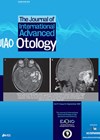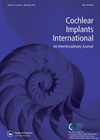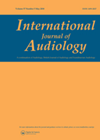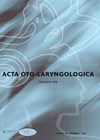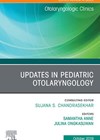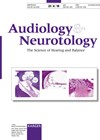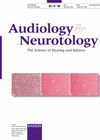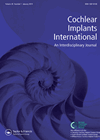
Journal Reviews
Cochlear implantation following radiotherapy treatment of vestibular schwannomas
The authors presented a case report and systematic review assessing the outcomes of patients from cochlear implantation (CI) following radiotherapy treatment for vestibular schwannoma (VS). Outcomes of cochlear implantation in these patients are uncertain due to the combination of both...
Hidden disabilities and cochlear implantation under 12 months of age
There has been a global shift to providing children with severe-profound deafness cochlear implants (CIs) before they are 12 months old. Early intervention is critical and one of the overriding factors in successful outcomes for children with CIs. Early implantation...
CATE in people with dementia
Behavioural hearing tests may be difficult to perform for people with dementia. The aim of this study was to investigate if the cortical automatic threshold estimation (CATE) may be used as an alternative to the pure tone audiometry test. Six...
Herpes zoster and SSNHL
Some studies suggest that viral infections may increase the risk of a sudden sensorineural hearing loss (SSNHL). The described longitudinal study explored whether herpes zoster may be a factor that increases the risk of SSNHL. Medical history in reference to...
Speech in noise hearing difficulties
The phenomenon of speech understanding in noise in normal hearing people attracts the interest of researchers continuously. This study’s aim was to further explore the possible reasons behind these difficulties. The participants were 50 adults that reported having normal hearing...
Intratympanic steroids - to give or not to give?
The treatment of idiopathic sudden sensorineural hearing loss (ISSNHL) is controversial and different modes of steroids have been tried without any universal consensus. Various authors have reported combined oral and intratympanic steroid therapy in SSNHL, with consistent results in several...
Hearing disability questionnaires
This is a very interesting study concerning the validity and readability of 10 hearing disability English language questionnaires available for clinical use. The questionnaires were assessed against the World Health Organisation’s International Classification of Functioning, Disability and Health framework (WHO-ICF)....
Understanding osseointegration for the otologist
Bone conduction implants are hearing devices that require osseointegration to create a stable and reliable interface between the hearing device and the skull to deliver sound to the cochlea. This article reviews the physiology of osseointegration, factors that may lead...
Round window niche drilling with intratympanic for ISSHL. A new option for salvage?
This paper from China compares the technique of widening the round window via a posterior tympanotomy approach and steroid-soaked gelatin sponge with intratympanic steroids alone for salvage therapy in severe idiopathic sensorineural hearing loss. Salvage therapy was defined as patients...
Virtual human speaker
The aim of the discussed study was to develop and evaluate a 3D virtual speaker that could use pre-recorded audio-material and possibly be used for audio-visual speech testing in the future. The authors developed the terminal-analogue method that allows to...
Is there a role for hyperbaric treatment in sudden hearing loss?
Sudden sensorineural hearing loss is a common presentation to ENT departments with a significant difference in management both at a local and regional level. The authors seek to clarify the role of hyperbaric oxygen therapy in combination with oral and...
Cognition outcomes after cochlear implantation – is there an improvement?
Older adults with a severe to profound hearing loss are more at risk of cognitive decline than adults of a similar age with milder losses or normal hearing. This poses challenges, not only in the assessment process, but also for...

